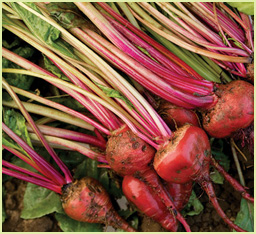
RECIPES
Fennel, Apple, and Radish Salad
Roasted Beet Salad alla Caprese
Pineapple and Jicama Salad with Honey Vinaigrette
Brown Rice and Chickpea Rainbow Salad
Mediterranean Spinach and Orzo Salad
Lemon Couscous Salad with Spinach
Farro Salad with Edamame and Arugula
Bulgur and Grilled Vegetable Salad
ECO-MINDED LIVING
COMPOSTING YOUR KITCHEN SCRAPS
USING COLD WATER HELPS US GET OUT OF ENVIRONMENTAL HOT WATER
SELECTED PRIMERS
Plus 9 more useful tips.
EARTHBOUND FARM’S ORGANIC CAFE IS PART OF OUR FARM STAND, located in Carmel Valley, California. There, surrounded by farm-fresh organic produce, and equipped with a pantry stocked with many types of organic whole grains and pastas, our Executive Chef, Sarah LaCasse, makes sure that the popular all-organic salad bar always includes about eight delicious vegetable and grain salads. She prepares them to reflect the season, using whatever is at its peak of freshness and flavor. I am there almost every day to get my favorite lunch—a huge salad from our salad bar—I always include a mix of these hearty salads to add variety, texture, and enough substance to fill me up.
All but one of the recipes in this chapter are vegetarian, so as a whole, they are light on the environment, as well as deliciously filling. Included are several unusual salads to satisfy your craving for something crunchy, like the Baby Turnip and Carrot Salad, which combines super-thin slices of carrots and sweet-and-peppery baby turnips in a simple but refreshingly light dressing of shallots, lemon juice, and a mixture of olive and canola oils. Another different crunchy combination is the Fennel, Apple, and Radish Salad, which mixes sweet apples, the subtle heat of radishes, and the distinctive anise flavor of fennel. And if you feel like eating something colorful and light, our Thai Cabbage Salad is perfect: a beautiful mix of red cabbage, English cucumbers, mint, and basil in a light Asian-style vinaigrette.

Beets—try them in our Roasted Beet Salad alla Caprese (page 242).
I’ve also included a variety of scrumptious salads featuring whole grains. The Brown Rice and Chickpea Rainbow Salad, flavored with a zesty pesto vinaigrette, is a visual feast that includes red tomatoes, pale green cucumbers, and dark Kalamata olives. With the protein and fiber of chickpeas and brown rice, this dish is filling and delicious. If you haven’t discovered farro yet, I highly recommend it.
This ancient grain quickly became one of my family’s all-time favorites. Try the Farro Salad with Edamame and Arugula—a great choice both for taste and nutrition. And I can’t seem to get enough of the Bulgur and Grilled Vegetable Salad. When there is a batch in my fridge, I’ll heat a bowlful as an entrée, eat it at room temperature to complement a half sandwich, or add a couple of cold heaping tablespoons to a salad to make it more flavorful and filling. The bulgur salad also makes a beautiful appetizer, scooped onto whole lettuce leaves, like Bibb or romaine hearts, and arranged in an attractive pattern on a platter.
Nearby farms supply our organic café with a beautiful array of potatoes, and the potato salad recipes in this chapter explore the flavors, colors, and textures of different potato varieties. The German Potato Salad showcases Yukon Gold, Red Bliss, or Yellow Finn potatoes. And as pleasing to the eye as to the taste buds, the Three-Color Potato Salad adds colorful vegetables, such as tomatoes and fresh green beans, to the mix.
Actually, harvesting fresh potatoes is one of my favorite things to do. It’s like a treasure hunt: carefully loosening the ground with a pitchfork, then kneeling down and sinking my hands elbow-deep in the fragrant, warm earth to look for the small new potatoes. As many times as I’ve done this, it’s still exciting to find the potatoes and carefully brush away the excess soil from the tender skins. When digging for potatoes, it’s especially comforting to know they were grown organically. The joy of digging and eating these tasty root vegetables isn’t marred by worries about pesticides on my hands or in my food.
Like harvesting fresh organic potatoes, the salads in this chapter are all wonderfully satisfying. Whether you’re going for extra crunch, a light side dish, a more filling addition to a leafy salad, or a delicious meatless entrée, these salads offer endless possibilities.
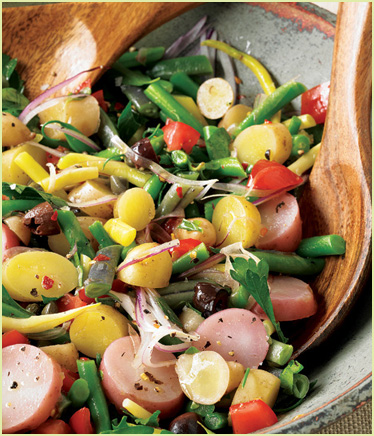
Three-Color Potato Salad (page 258)
Fennel, Apple, and Radish Salad
THE SUBTLE ANISE FLAVOR OF FRESH FENNEL partners perfectly with sweet-tart apple, and the radish slices add a spark of peppery heat. Both the fennel and apple will discolor after slicing, so be sure to toss these ingredients with the dressing immediately after prepping them. The concept of this fabulously fresh-tasting salad is really simple: Cut an assortment of seasonal raw vegetables into paper-thin slices, toss them with a light dressing, and add a shower of fresh herbs. Experiment to create your own versions, keeping in mind that you’ll want a balance of color, texture, and flavor. We prefer the super-thin, even slices you get by using a mandoline (see the sidebar on page 240), but if you cut the vegetables by hand and your slices are thicker, the salad will still be delicious.  Serves 4 to 6
Serves 4 to 6
1 large fennel bulb
¼ cup extra-virgin olive oil
2 tablespoons fresh lemon juice
1 tablespoon unseasoned rice vinegar
½ teaspoon snipped chives or minced scallion tops (green part)
Salt and freshly ground black pepper
1 large crisp apple, such as Fuji or Gala
12 large radishes, trimmed and thinly sliced (about 2 cups)
1. Snip enough of the fennel fronds to measure 1 tablespoon. Set the fennel bulb aside.
2. Combine the olive oil, lemon juice, vinegar, fennel fronds, chives, ¼ teaspoon salt, and black pepper to taste in a glass jar and seal the lid tightly. Shake the jar vigorously to combine. (Any leftover vinaigrette can be refrigerated, covered, for up to 1 week. Let it return to room temperature and then shake vigorously before using.)
3. Trim the fennel bulb, cut it in half lengthwise, and then thinly slice the halves. Quarter and core the apple, then thinly slice it.
4. Place the fennel, radish, and apple slices in a large bowl and add three-quarters of the vinaigrette to the vegetables. Toss to lightly coat the salad, and then taste to see if more dressing is needed. Season the salad with salt and pepper to taste. Transfer the salad to a platter or individual salad plates. (The salad will lose its crunchiness over time, but it can be refrigerated, covered, for up to 2 days.)
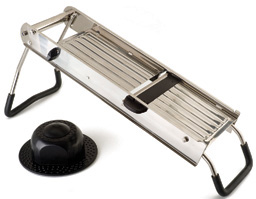
PAPER-THIN ROUNDS OF RAW BABY TURNIPS AND CARROTS are moistened with a fresh lemon-parsley dressing to make an unusual and remarkable salad. Baby white turnips are sweet and juicy, with a mild hint of pepperiness. They are a world removed from their mature cousins, which are often hard and stringy and have a very sharp bite. Mid-March through June is the peak season for tender baby turnips. Look for very small turnips with a diameter about the same as the carrots’. If you can find purple or red carrots, use an assortment of hues to add a colorful note. This salad benefits from a short marination, up to 2 hours, to allow the flavors to develop and meld. Anything much longer than this, however, and the salad will begin to lose its appealing crunch and vivid colors.  1 Serves 4
1 Serves 4
6 baby white turnips, golf-ball-size, washed and trimmed
2 large carrots, peeled
¼ cup minced fresh flat-leaf parsley
½ tablespoon minced shallot
¼ teaspoon minced garlic
2 tablespoons fresh lemon juice
3 tablespoons extra-virgin olive oil
2 tablespoons canola oil
Sea salt and freshly ground black pepper, to taste
1. Using a mandoline (see sidebar, this page), slice the turnips into paper-thin rounds. (Alternatively, use a sharp knife to slice the turnips as thin as possible.) Transfer the turnips to a medium-size bowl. Slice the carrots in the same manner, using only the thickest part of the carrots so that all the rounds are approximately the same size. Add the carrots to the bowl. (Unused parts of the carrots can be saved for stocks, soups, or healthy snacks.) You want roughly equal quantities of turnip and carrot for the salad. Stir in the parsley.
2. Combine the shallot, garlic, and lemon juice in a glass jar and seal the lid tightly. Let this mixture marinate at room temperature for 10 minutes.
3. Add the olive and canola oils to the shallot mixture, seal the lid tightly, and shake vigorously to combine. Season to taste with sea salt and pepper. (The dressing can be refrigerated, covered, for up to 5 days. Let it return to room temperature and then shake vigorously before using.)
4. Add the dressing to the turnip-carrot mixture, tossing to coat. Season the salad with sea salt and pepper to taste. Refrigerate the salad, covered, for up to 2 hours before serving.
5. Transfer the salad to a platter or individual salad plates, and serve.
INSALATA CAPRESE, THE SUBLIME ITALIAN CLASSIC that marries tomatoes, basil, and mozzarella di bufalo, is spectacular when sun-ripened tomatoes are in season. But from December to June, when tomatoes are lackluster, sweet earthy beets make an excellent substitution. In our unorthodox version of this popular salad, disks of meltingly soft mozzarella alternate with roasted beets and rounds of juicy citrus. Drizzled with an orange-scented vinaigrette, the salad is a beautiful study in colors and textures as well as a pleasure for the palate. Be sure to use soft fresh milk or buffalo milk mozzarella sold in water, not the hard mozzarella that is used for grating and has a plastic texture. If fresh basil is not available, use arugula or parsley as a winter substitute.  Serves 4 to 6
Serves 4 to 6
4 medium beets, preferably 2 red and 2 golden, scrubbed and trimmed (see sidebar, this page)
1 tablespoon olive oil
Salt and freshly ground black pepper, to taste
2 tablespoons red wine vinegar
Grated zest of 1 orange
1 tablespoon fresh orange juice
1 teaspoon Dijon mustard
1 teaspoon honey, or more to taste
⅓ cup extra-virgin olive oil
2 balls (4 to 6 ounces each) fresh milk or buffalo milk mozzarella cheese, drained and patted dry
2 medium oranges
Sea salt, to taste
¼ cup fresh basil leaves, sliced in very thin ribbons, or opal basil sprigs
1. Position a rack in the middle of the oven and preheat the oven to 400°F.
2. Dry the beets with paper towels and rub them with the tablespoon of olive oil. Season them with salt and pepper, and then wrap each beet individually in aluminum foil, sealing it tightly. Place the beets directly on the oven rack and roast until they are very tender, 50 to 60 minutes, depending on their size.
3. Remove the beets from the oven and let them cool on a rack (still in their foil packets) until they are cool enough to handle, 30 to 40 minutes. (The cooked beets can be refrigerated, tightly wrapped, for up to 2 days in advance. Return the beets to room temperature before proceeding with the recipe.)
4. Peel the beets or rub off the skins with a clean kitchen towel. Cut the beets into ¼-inch-thick rounds, discarding the top and bottom pieces.
5. Place the vinegar, orange zest, orange juice, mustard, honey, and extra-virgin olive oil in a glass jar. Cover the jar tightly with a lid and shake it vigorously to combine. Season the dressing with salt and pepper to taste, and add more honey if you prefer a sweeter flavor. Set the dressing aside at room temperature while you finish the salad (or refrigerate it for up to 5 days).
6. Cut the mozzarella into ¼-inch-thick slices. Place the cheese on a platter and drizzle with some of the vinaigrette. Let stand at room temperature for 20 to 30 minutes.
7. Cut off a thin slice from the top and bottom of each orange so that the fruit will sit level on a cutting board. Using a sharp paring knife, remove wide strips of the peel and white pith by cutting downward, following the contour of the fruit. Leave the flesh intact. Cut the oranges crosswise into ¼-inch-thick slices.
8. To assemble the salad, arrange slices of beets, cheese, and oranges in an attractive overlapping pattern. Drizzle the salad with some of the vinaigrette, and season it lightly with sea salt and freshly ground pepper. Scatter the basil ribbons over the salad, and serve at room temperature. The beets will bleed and color the cheese, but that is part of the effect.
Roasted Beet Salad alla Caprese in a casual, family-style presentation
THERE’S NO SHORTAGE OF CRUNCH in this tasty and colorful slaw. The simple mayonnaise-based dressing can be made up to 3 days ahead of assembling the salad, and the slaw itself can be made a day ahead, then covered and stored in the refrigerator. Don’t add the cashews until serving time, though, because they will get soggy if they are tossed with the slaw ahead of time.  Serves 6 to 8
Serves 6 to 8
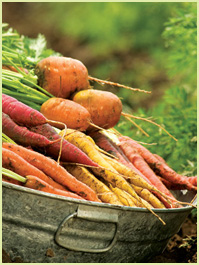
A colorful display of carrots.
4 medium carrots, peeled and grated (about 3 cups)
1 cup finely shredded red cabbage
1 crisp apple, such as Gala or Fuji, cored, peeled, and grated
⅓ cup raisins
½ cup mayonnaise
¼ cup apple juice
2 tablespoons apple cider vinegar
1 tablespoon fresh lemon juice
Salt and freshly ground black pepper
½ cup salted cashews, chopped
1. Place the carrots, cabbage, apple, and raisins in a large bowl.
2. Combine the mayonnaise, apple juice, cider vinegar, and lemon juice in a small bowl, and whisk to blend.
3. Add the mayonnaise mixture to the carrot mixture and stir to combine. Season with salt and pepper to taste. Just before serving, stir in the cashews. Serve immediately.
SWEET CUBES OF FRESH PINEAPPLE meld with crunchy, juicy jicama, creamy avocado, and toasted pecans in an unusual and refreshing salad that is great for picnics or as an accompaniment to spicy Mexican dishes. The vinaigrette marries all the disparate elements of this salad. The honey flavor is quite predominant, so pick a mild honey or one whose flavor you know you like. For the best results, let the pineapple and jicama marinate in the dressing for at least an hour before finishing and serving the salad.  Serves 4 to 6
Serves 4 to 6
HONEY DRESSING
⅓ cup mild-flavored honey
1 tablespoon hot water
Grated zest of 1 orange
¼ cup apple cider vinegar
1 teaspoon salt
Freshly ground black pepper, to taste
1½ tablespoons extra-virgin olive oil
SALAD
½ fresh pineapple, peeled, cored, and cut into ¼-inch cubes
12 ounces jicama, peeled and cut into ¼-inch cubes
½ small red onion, very thinly sliced
⅓ cup thinly sliced fresh mint leaves (optional)
2 ripe avocados, preferably Hass, pitted, peeled, and cut into ⅓-inch cubes
1 cup pecan halves, toasted (see box, page 31)
1. Prepare the dressing: Combine all the dressing ingredients in a glass jar and seal the lid tightly. Shake the jar vigorously until the honey dissolves. Let the dressing sit at room temperature while you assemble the salad.
2. Prepare the salad: Place the pineapple, jicama, and red onion in a medium-size bowl. Toss with ⅓ cup of the dressing, stirring to coat. Cover the bowl with a plate or a clean kitchen towel and refrigerate the salad for 1 hour, or up to 4 hours, stirring to coat the fruit and vegetables several times.
3. Add the mint, if using, to the salad and stir to blend. Transfer the salad to a serving bowl or platter. Arrange the avocados and pecans on top of the salad, drizzle with more of the dressing, and serve immediately. (Serve the remainder of the dressing on the side.) The salad can be refrigerated, covered, for up to 2 days.
I LOVE THE CRUNCH OF THIS BEAUTIFUL SALAD as well as its brilliant colors. The combination of sugar, citrus, and jalapeño pays homage to the elemental Thai trinity of sweet-sour-spicy. The salty crunch of peanuts is the crowning touch, but be sure to add them just at serving time so they don’t get soggy.  Serves 4
Serves 4
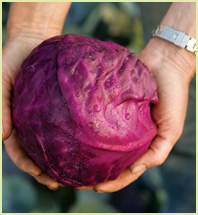
Choose cabbages with the tightest heads and the deepest red leaves.
About 8 ounces red cabbage, thinly sliced (2 cups)
2 medium carrots, peeled and coarsely chopped (about 1½ cups)
½ cup coarsely grated seedless (English) cucumber (peeled or unpeeled)
3 tablespoons finely diced jalapeño pepper, with or without seeds (see sidebar, page 12)
3 tablespoons chopped fresh mint or cilantro
3 tablespoons chopped fresh basil
2 tablespoons fresh lime juice
2 tablespoons canola oil
1 teaspoon minced peeled garlic
2 teaspoons fish sauce (see box, page 156)
2 teaspoons sugar
¼ teaspoon dried red pepper flakes, or to taste
1 cup salted dry-roasted peanuts (optional)
1. Place the cabbage, carrots, cucumber, jalapeño, mint, and basil in a large bowl and stir to combine.
2. Combine the lime juice, oil, garlic, fish sauce, sugar, and red pepper flakes in a small glass jar and seal the lid tightly. Shake the jar vigorously to combine. (The vinaigrette can be refrigerated, covered, for up to 1 week.)
3. Add three-quarters of the dressing to the cabbage mixture, and toss to combine. Taste, and add more dressing if needed. Just before serving, stir in the peanuts if using.
SOBA ARE LONG, THIN, FLAT JAPANESE NOODLES made from a combination of buckwheat and wheat flours. The buckwheat gives them their distinctive beige-brown color and nutty flavor. Slivers of crunchy radish and carrot add texture and color to this salad, which is very light and fresh tasting, with a subtle hint of sesame flavor. It goes well with grilled chicken or fish.  Serves 6 to 8
Serves 6 to 8
8 ounces dry soba (buckwheat) noodles
¼ cup plain sesame oil (see sidebar, page 25)
½ cup unseasoned rice vinegar
3 cups julienne-cut, seeded, peeled cucumber
2 cups grated carrots
2 cups grated radishes (about 16 radishes)
6 scallions (white part and 3 inches of green), thinly sliced
1½ teaspoons salt
Freshly ground black pepper, to taste
2 tablespoons sesame seeds, toasted (see box, page 31)
1. Bring a large pot of salted water to a boil over high heat. Reduce the heat to medium and add the noodles. Cook at a slow simmer until the noodles are just tender, 7 to 10 minutes. Transfer the noodles to a colander and set it under cold running water to stop the cooking. Drain well, and transfer the noodles to a large bowl.
2. Mix the sesame oil and vinegar together in a small bowl.
3. Add the cucumber, carrots, radishes, and scallions to the noodles, and toss to combine. Add the dressing, salt, and pepper, and toss to coat. Transfer the salad to a serving platter, sprinkle with the sesame seeds, and serve. The salad can be refrigerated, covered, for up to 5 days.
Chicken Salad with Two Rices
WILD RICE IS DARK AND GLOSSY, with a rich, nutty flavor and a chewy texture. Admittedly, it is expensive, but a little goes a long way. Here we’ve added tender strips of chicken, toasted pecans, and the sweet burst of citrus to the rice to create a one-dish meal. Roast your own chicken or use a store-bought rotisserie chicken for this salad. Oranges are easier to eat in a salad when you remove the bitter white pith that snuggles beneath the peel, so it’s worth the time to segment the fruit instead of slicing it into rounds.  Serves 4
Serves 4
¾ cup wild rice, rinsed well (or 3 cups cooked wild rice; see sidebar, page 253)
1 teaspoon salt
About 3 cups cold water
2 cups cooked chicken, shredded or cut into ½-inch dice
⅔ cup diced celery (½-inch dice)
½ cup pecans, toasted and coarsely chopped (see box, page 31)
2 large oranges
½ cup Golden Balsamic Vinaigrette (recipe follows)
¼ cup chopped celery leaves
1. Place the wild rice and the salt in a medium-size saucepan, add enough cold water to cover by ½ inch, cover the pan, and bring to a boil over high heat. Then reduce the heat to medium and cook slowly until the rice is tender, 40 to 50 minutes. Drain the rice and let it cool to room temperature.
2. Place the rice, chicken, celery, and pecans in a large bowl and stir to combine.
3. Cut off both ends of each orange to create a flat surface so that the fruit can sit level on a cutting board. Using a sharp paring knife, remove wide strips of the peel and pith by cutting downward, following the contour of the fruit. Leave the flesh intact. Holding the orange over a bowl to catch the juice, slice between the white membranes to release the fruit in segments. Cut the orange segments in half crosswise to form bite-size pieces. Add the oranges and the reserved juice to the salad.
4. Add the vinaigrette and celery leaves and toss gently to combine. Serve immediately, or refrigerate, covered, until serving time. The salad is best eaten the day it is made.
If you have never tried golden balsamic vinegar, do! It is lighter and fresher tasting than the traditional dark balsamic vinegar—still intense, but with a hint of fruitiness. And it won’t darken foods the way regular balsamic does.  Makes about 1 cup
Makes about 1 cup
½ cup extra-virgin olive oil
¼ cup plus 2 tablespoons golden balsamic vinegar
¼ cup canola oil
1½ teaspoons sugar
1 teaspoon minced garlic
1 teaspoon minced shallot
½ teaspoon dried thyme leaves
¼ teaspoon salt
¼ teaspoon freshly ground black pepper
Place all the ingredients in a glass jar and seal the lid tightly. Shake the jar vigorously until the sugar dissolves. (The vinaigrette can be refrigerated, covered, for up to 1 month. Let it return to room temperature and then shake vigorously before using.)
WILD RICE, WHICH REALLY ISN’T RICE AT ALL, has a terrific chewy texture and nutty flavor. Unlike true rice, which can get mushy when tossed with vegetables and salad dressing, it holds up beautifully in composed salads. In this hearty salad, crunchy toasted almonds boost the nuttiness of the rice, shiitake mushrooms add a rich, earthy note, and dried cranberries lend a touch of sweetness to every bite. This salad makes great picnic or barbecue fare, and it can be served as a room-temperature side dish with grilled fish or roast chicken.  Serves 6 to 8
Serves 6 to 8
1 cup wild rice, rinsed well (or 4 cups cooked wild rice; see sidebar, this page)
Salt
About 4 cups cold water
3 tablespoons canola oil
8 ounces shiitake mushrooms, stems removed, caps thinly sliced (about 4 cups)
1 cup whole almonds (skins on), toasted and coarsely chopped
¾ cup dried unsweetened cranberries
¼ cup thinly sliced scallions (white part and 3 inches of green)
About ¾ cup Golden Balsamic Vinaigrette (facing page)
Freshly ground black pepper
1. Place the rice and 1 teaspoon salt in a medium-size saucepan and add enough cold water to cover by ½ inch. Bring to a boil, covered, over high heat. Then reduce the heat to medium and cook gently until the rice is tender, 40 to 50 minutes. Drain the rice and transfer it to a large mixing bowl.
2. Heat the oil in a large skillet over medium-high heat. Add the mushrooms and cook, stirring frequently, until they are tender, 6 to 8 minutes. Add the mushrooms to the rice, and stir in the almonds, cranberries, and scallions.
3. Add about ½ cup of the Golden Balsamic Vinaigrette to the rice mixture, stirring to combine. Taste, and add more dressing (sparingly) if needed. Season with salt and pepper to taste. The salad can be served at room temperature or cold. (It can be refrigerated, covered, for up to 5 days.)
THE TITLE OF THIS RECIPE just hints at how special this salad is. True, brown rice and chickpeas play starring roles, but tomatoes, cucumbers, red onion, and Kalamata olives add beautiful color, texture, and flavor to the dish. Moistened with a zesty Pesto Vinaigrette, this is a deliciously different, nutritious salad that makes a great addition to a picnic or barbecue and suffices as a stand-alone vegetarian meal.  Serves 6 to 8
Serves 6 to 8
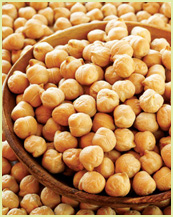
Versatile chickpeas are a good source of protein.
1 cup short-grain brown rice
Salt
1 cup cooked chickpeas (garbanzo beans; see box, page 422), rinsed and drained if canned
2 medium tomatoes, cored, seeded, and cut into ¼-inch dice (about 1¼ cups)
1 cucumber, peeled, seeded, and cut into ¼-inch dice (1 cup)
1 small red onion, cut into ¼-inch dice (about 1 cup)
¾ cup Kalamata olives, pitted and sliced
½ cup chopped fresh flat-leaf parsley
1 tablespoon fresh lemon juice
About ¾ cup Pesto Vinaigrette (recipe follows)
Freshly ground black pepper
1. Place the rice, 2¼ cups water, and 1 teaspoon salt in a small saucepan, cover, and bring to a boil over medium-high heat. Reduce the heat to maintain a simmer and cook until the water has been absorbed and the rice is tender or nearly so, 30 to 40 minutes. Check the water level once or twice during cooking to make sure that it has not evaporated, and add a little more water if needed.
2. Remove the pan from the heat, and spread the rice on a rimmed baking sheet so that it will cool quickly. (You should have about 3 cups.)
3. Place the rice, chickpeas, tomatoes, cucumber, red onion, olives, parsley, and lemon juice in a large bowl and stir to combine.
4. Add ½ cup of the Pesto Vinaigrette to the mixture, and toss to coat. Taste, and add more dressing if needed. Season with salt and pepper to taste, and serve chilled or at room temperature. (The salad can be refrigerated, covered, for up to 5 days.)
The deep emerald-green color of this salad dressing matches the vibrancy and intensity of its flavor. Similar to pesto in taste, but with a bit more acidity, the vinaigrette stands up well to hearty salads. It’s also delicious in pasta salads and in green salads based on sturdy lettuces such as radicchio, romaine, or iceberg.  Makes about ¾ cup
Makes about ¾ cup
½ cup (packed) fresh basil leaves
¼ cup unseasoned rice vinegar
1 small shallot, halved
1 tablespoon pine nuts
1 tablespoon freshly grated Parmesan cheese
1 large clove garlic, peeled
1 teaspoon salt
½ teaspoon freshly ground black pepper
¼ cup extra-virgin olive oil
2 tablespoons canola oil
1. Place the basil, vinegar, shallot halves, pine nuts, Parmesan, garlic, salt, and pepper in a blender or food processor. Pulse until the mixture forms a finely chopped coarse paste, stopping once or twice to scrape the sides of the bowl with a rubber spatula.
2. With the machine running, add the olive and canola oils in a slow, steady stream, and process until fully emulsified. (The vinaigrette can be refrigerated, covered, for up to 1 week. Let it return to room temperature before using.)
LIGHT, SATISFYING, AND VISUALLY APPEALING, this salad combines an assortment of delicious ingredients that are staples of Mediterranean cuisine—spinach, sun-dried tomatoes, olives, and feta cheese. In the time it takes to cook the orzo, you can assemble the other components and make the vinaigrette. As an added bonus, this salad can be made a day ahead, covered, and refrigerated. For the best flavor, let the chilled salad come to room temperature before serving.  Serves 4 to 6
Serves 4 to 6
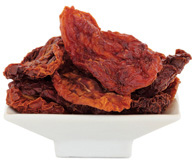
Sun-dried tomatoes
1 cup orzo pasta, preferably whole wheat
4 ounces fresh baby spinach, well rinsed and patted dry if needed
⅓ cup oil-packed sun-dried tomatoes, chopped
½ cucumber, peeled, seeded, and diced
¼ cup Kalamata olives, pitted and chopped
2 teaspoons chopped fresh oregano, or ¾ teaspoon dried
Red Wine Vinaigrette (recipe follows)
Salt and freshly ground black pepper
2½ ounces feta cheese, crumbled (½ cup)
1. Bring a large covered saucepan of salted water to a boil over high heat. Add the orzo and cook according to the package directions until just tender, 9 to 11 minutes. Drain, and rinse under cold running water until the pasta cools to room temperature. Drain well again, and transfer the orzo to a large bowl.
2. Add the spinach, sun-dried tomatoes, cucumber, olives, and oregano to the orzo and toss to combine.
3. Add half of the Red Wine Vinaigrette and toss again. Taste, and add more dressing if desired. Season with salt and pepper to taste.
4. Transfer the salad to a platter, and sprinkle with the feta. Serve at room temperature.
This classic vinaigrette, with its vibrancy and assertive flavors, is delicious paired with all leafy greens and is robust enough to stand up to heartier grain or pasta salads.  Makes about 1 cup
Makes about 1 cup
½ cup extra-virgin olive oil
¼ cup canola oil
¼ cup red wine vinegar
1 teaspoon minced shallot
½ teaspoon minced garlic
½ teaspoon sugar
½ teaspoon salt
¼ teaspoon dried thyme
¼ teaspoon dried oregano
¼ teaspoon freshly ground black pepper
Place all the ingredients in a glass jar and seal the lid tightly. Shake the jar vigorously to combine. (The vinaigrette can be refrigerated, covered, for up to 1 month. Let it return to room temperature and then shake vigorously before using.)
Note: This vinaigrette recipe makes double the amount you need for the Mediterranean Spinach and Orzo Salad. But it stores well and is a great dressing to have on hand for just about any type of salad.
I GROW DIFFERENT TYPES OF NEW POTATOES in my garden, and this recipe may be my favorite way to serve them. The salad is a glorious combination of potatoes with green beans, tomatoes, olives, capers, and parsley. It’s a perfect dish to bring to a picnic or potluck.  Serves 6 to 8
Serves 6 to 8
1½ pounds small new potatoes, preferably in assorted colors such as red, purple, and yellow, scrubbed (peeling optional)
Salt
About 4 cups cold water
About 8 ounces fresh green beans or wax beans, or a combination of both, trimmed, blanched (see sidebar, page 163), and cut into 1-inch lengths (1½ cups)
2 large ripe tomatoes, cored and cut into ½-inch dice
1 small red onion, halved through the stem end, then very thinly sliced crosswise
½ cup Kalamata olives, pitted and halved
⅓ cup chopped fresh flat-leaf parsley
2 tablespoons capers, drained
Pinch of dried red pepper flakes
¼ cup extra-virgin olive oil
1 tablespoon fresh lemon juice
1 teaspoon dried oregano
Freshly ground black pepper
1. Place the potatoes in a large pot, and add 1 tablespoon salt and enough cold water to cover. Cover the pot and bring the water to a boil over high heat. Then reduce the heat to medium-low and simmer until the potatoes are tender, 20 to 30 minutes, depending on their size.
2. While the potatoes are cooking, place the green beans, tomatoes, red onion, olives, parsley, capers, and red pepper flakes in a large mixing bowl, and stir gently to combine.
3. Combine the olive oil, lemon juice, and oregano in a small glass jar and seal the lid tightly. Shake the jar vigorously to combine. Season the vinaigrette with salt and pepper to taste, and set it aside at room temperature.
4. When the potatoes are tender, drain them immediately, and then let them cool until they can be handled. Cut the potatoes into small pieces, and add them to the bean mixture. Pour the vinaigrette over the vegetables, and toss gently to coat thoroughly. Season with salt and pepper, if desired. The salad can be served at room temperature or chilled. (It can be refrigerated, covered, for up to 3 days.)
Three-Color Potato Salad
POTATO SALAD IS A PERENNIAL FIXTURE at picnics and barbecues, popular with just about everyone. There are as many versions as there are cooks; this one is a classic German preparation, enlivened with bacon and vinegar. The potatoes are steamed rather than boiled, so that they retain their shape and vitamins. If you prefer more crunch in your potato salad, customize the recipe by adding diced celery, red onion, dill pickles, or whatever you like best.  Serves 6 to 8
Serves 6 to 8
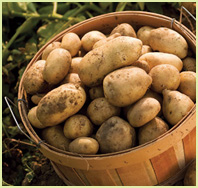
If you scrub the potato skins well, there’s no need to peel them off.
2 pounds thin-skinned waxy potatoes, such as Yukon Gold, Red Bliss, or Yellow Finn, cut into ¾-inch chunks (peeling optional)
8 ounces thick-sliced bacon, cut into ½-inch pieces
2 tablespoons distilled white vinegar
1 cup mayonnaise
1 bunch scallions, thinly sliced (white part and 3 inches of green, about ½ cup sliced)
¼ cup chopped fresh flat-leaf parsley
Salt and freshly ground black pepper
1. Pour water to a depth of about 1 inch into a saucepan, cover the pan, and bring the water to a boil over medium-high heat. Place the potatoes in a steamer basket, set it over the boiling water, cover the pan, and steam the potatoes until they are tender when pierced with the tip of a knife, 10 to 15 minutes.
2. Meanwhile, cook the bacon in a skillet over medium-low heat, turning it occasionally, until crisp, about 15 minutes. Transfer the bacon to paper towels to drain. Turn off the heat, and discard all but 1 tablespoon of the fat. Add the vinegar to the skillet and stir to blend.
3. Place the mayonnaise in a small bowl, and add the vinegar-fat mixture, stirring to combine.
4. Drain the potatoes in a colander and transfer them to a large bowl. Add half of the mayonnaise mixture to the still-hot potatoes and stir to combine; reserve the remaining mayonnaise mixture. Let the potatoes cool to room temperature.
5. When the potatoes are at room temperature, add the bacon, scallions, parsley, and the remaining mayonnaise mixture, and stir to combine. Season with salt and pepper to taste. Serve immediately, or refrigerate the salad, covered, until serving time. (It can be refrigerated for up to 3 days.)
LIGHT AND LEMONY, this simple preparation makes a nice side dish that goes with just about everything. The spinach is blended into the warm couscous, so it wilts just a bit. The lemon dressing and fresh dill perk up the couscous, giving it brightness and flavor, while toasted walnuts add crunch to the medley. The salad can be made a day ahead, but add the walnuts just before serving so they don’t get soggy. For maximum flavor, let the salad come to room temperature before serving.  Serves 6
Serves 6
1¼ teaspoons salt
1½ cups couscous
2 cups (3 ounces) packed baby spinach leaves, well rinsed and patted dry if needed, cut into thin ribbons
4 scallions (white part and 3 inches of green), thinly sliced
3 tablespoons chopped fresh dill
¼ cup extra-virgin olive oil or walnut oil
3 tablespoons fresh lemon juice
¼ teaspoon freshly ground black pepper
½ cup walnut pieces, toasted
1. Bring 2 cups water and ½ teaspoon of the salt to a boil in a small saucepan over high heat.
2. Place the couscous in a large heatproof mixing bowl and add the boiling water. Immediately cover the bowl with a kitchen towel. Let it sit until the water is absorbed, about 7 minutes. Fluff the couscous with a fork.
3. While the couscous is still warm, add the spinach, scallions, and dill, stirring to combine.
4. In a small bowl, whisk together the olive oil, lemon juice, remaining ¾ teaspoon salt, and the pepper. Add the dressing to the couscous, stirring to coat. Add the walnuts, and serve at room temperature. (The salad can be refrigerated, covered, for up to 3 days.)

Fresh baby spinach ready for harvesting.
Farro Salad with Edamame and Arugula
WE ALL KNOW THAT ADDING HEALTHY WHOLE GRAINS to our diet is important, but most of us fall short of the daily recommended three servings. If you’re looking for something enticing in the grain category, farro may become your new favorite. This ancient grain is easy to cook and has a wonderful nutty flavor and an appealing chewy texture. Here we’ve paired it with edamame (Japanese green soybeans), which are rich in vitamins, minerals, protein, and omega-3 fatty acids, and with peppery, nutrient-rich arugula.  Serves 6 to 8
Serves 6 to 8
Salt
1¼ cups farro (see box, page 264)
1½ cups shelled fresh (1½ pounds unshelled) or frozen edamame (soybeans), thawed if frozen
2 cups lightly packed arugula, coarsely chopped
½ cup thinly sliced scallions (white part and 3 inches of green)
¾ cup Tomato Vinaigrette (recipe follows)
Freshly ground black pepper
1. Bring 6 cups of water to a boil in a large covered saucepan over high heat. Add 1 tablespoon salt and the farro, and return to a boil. Then reduce the heat to medium-low and cook, stirring occasionally, until the farro is puffed and slightly chewy, 20 to 30 minutes. (Do not overcook, or the farro will be mushy.) Drain the farro immediately, and rinse it under cold running water until it is cool. Drain again, and transfer it to a large bowl.
2. Bring a covered medium-size saucepan of water to a boil over high heat. Add the edamame and ½ teaspoon salt and cook until the edamame is crisp-tender, 3 to 5 minutes, or if frozen, according to the package directions.
3. Meanwhile, fill a medium-size bowl with ice water.
4. Drain the edamame and plunge it into the bowl of ice water. When the edamame is cool, drain it thoroughly and add it to the farro.
5. Add the arugula and scallions to the mixture, and toss to combine. Add ½ cup of the Tomato Vinaigrette and stir to combine. Taste, and add more dressing if desired. Season the salad with salt and pepper to taste, and serve at room temperature. (The salad can be refrigerated, covered, for up to 3 days.)
This fresh Tomato Vinaigrette adds a hint of sweetness to the farro salad—and if you have any dressing left over, it tastes great on leafy green salads, too.  Makes 1 cup
Makes 1 cup
2 large tomatoes, peeled, seeded, and chopped (¾ cup; see sidebar, page 131)
2 tablespoons white wine vinegar
1½ tablespoons chopped fresh oregano, or 1½ teaspoons dried
½ teaspoon minced peeled garlic
1 teaspoon salt
¼ teaspoon freshly ground black pepper
¼ cup extra-virgin olive oil
1. Place the tomatoes, vinegar, oregano, garlic, salt, and pepper in a food processor or blender, and puree until smooth. With the machine running, add the olive oil in a slow, steady stream.
2. Use immediately, or transfer the dressing to a glass jar, seal the lid tightly, and refrigerate for up to 1 week. Let it return to room temperature and then shake vigorously before using.
PANZANELLA IS A TRADITIONAL ITALIAN BREAD SALAD that probably originated as a thrifty way to use up bread that was no longer fresh. Cubes of day-old (or older) bread are tossed with tomatoes, cucumbers, onions, and peppers. A zesty dressing made with sun-dried tomatoes adds another dimension and moistens the bread so that the ingredients meld into a very flavorful meal. This is a salad that lets you be creative: Capers, olives, or anchovies are also delicious additions. The bread can be toasted if you want more crunch.  Serves 6
Serves 6
12 ounces day-old country-style bread, with crusts, cut into 1-inch cubes (8 cups)
4 large tomatoes, cored, seeded, and chopped, juices reserved
1 large cucumber, peeled, seeded, and cut into ½-inch dice
2 medium red, yellow, or green bell peppers, stemmed, seeded, and cut into ¼-inch dice (about 2 cups)
1 small red onion, cut into ¼-inch dice (1 cup)
¾ to 1 cup Sun-Dried Tomato Vinaigrette (recipe follows)
Salt and freshly ground black pepper
20 fresh basil leaves, cut into very thin ribbons
1. Place the bread in a large bowl, and add the tomatoes, cucumber, bell peppers, and red onion.
2. Add ¾ cup of the Sun-Dried Tomato Vinaigrette to the mixture, and toss to coat all the ingredients evenly. Taste, and add more vinaigrette if the salad is dry.
3. Season the salad with salt and pepper to taste, and garnish with the basil. The salad should be served within an hour or two of making. If made too far in advance, the bread will soak up all the dressing and you will need to add more.
Loaded with flavor, this vinaigrette is a perfect partner for our Panzanella Salad, but it’s also terrific tossed with sturdy greens such as romaine.  Makes about 2 cups
Makes about 2 cups
⅓ cup sun-dried tomatoes, reconstituted in hot water if not soft and pliable, chopped
½ teaspoon minced peeled garlic
½ cup red wine vinegar ¼ cup balsamic vinegar
½ cup canola oil
½ cup extra-virgin olive oil
Salt and freshly ground black pepper
1. Place the sun-dried tomatoes, garlic, and both vinegars in a food processor or blender. Puree until smooth, scraping the sides of the bowl once during processing, about 1 minute.
2. With the machine running, add the canola and olive oils in a slow, steady stream. The dressing will be thick. Add salt and pepper to taste. (The vinaigrette can be refrigerated, covered, for up to 2 months. For the best flavor, serve at room temperature.)
Bulgur and Grilled Vegetable Salad
BULGUR WHEAT IS A QUICK-COOKING GRAIN that works well in salads because it’s light and fluffy but still has a tender, chewy texture. Here I’ve added an assortment of colorful grilled vegetables, crumbles of briny feta cheese, and a zesty red wine vinaigrette to the bulgur, which soaks up the flavors in a delicious way. It is also makes a beautiful appetizer—simply top whole leaves of butter or romaine lettuce with about ¼ cup of the salad for each lettuce cup. The salad is meant to be served at room temperature, but I also like it served both cold and warm. It can be refrigerated, covered, for up to 5 days.  Serves 6 to 8
Serves 6 to 8
SALAD
2 cups bulgur wheat
3 cups cold water
Salt
3 medium zucchini, trimmed and cut lengthwise into ¼-inch-thick strips
1 large red onion, cut into ¼-inch-thick rounds
2 roasted red bell peppers (see page 411), cut into ½-inch pieces, or 2 raw red bell peppers, stemmed, seeded, and cut into large pieces
⅓ cup olive oil
Freshly ground black pepper
5 ounces feta cheese, crumbled (about 1 cup)
DRESSING
⅓ cup extra-virgin olive oil
2 tablespoons red wine vinegar
1½ tablespoons fresh lemon juice
1 tablespoon dried oregano
½ tablespoon minced peeled garlic
1 teaspoon salt
¼ teaspoon freshly ground black pepper
TO SERVE
Salt and freshly ground black pepper
1. Prepare the salad: Place the bulgur, cold water, and 1½ teaspoons salt in a large saucepan, cover, and bring to a boil over high heat. Reduce the heat to medium-low and cook until the bulgur is tender, 12 to 15 minutes. Drain off any excess water and transfer the bulgur to a large bowl, stirring to fluff the grains.
2. If you intend to grill the vegetables, place the zucchini, onion, and raw bell peppers, if using, in a bowl and toss with the olive oil, ½ teaspoon salt, and black pepper to taste. Grill over medium-high heat until the vegetables are tender, 3 to 8 minutes. (The zucchini will cook faster than the red peppers.) Set aside at room temperature.
If you are using a ridged grill pan or a cast-iron skillet for indoor cooking, heat the pan over medium-high heat. Add 2 tablespoons of the olive oil, and cook the zucchini until browned on one side, 2 to 3 minutes. Turn the strips over and cook on the other side until crisp-tender, another 1 or 2 minutes. Transfer the zucchini to a cutting board and let cool. Repeat with the raw red peppers, if using, and the onion rounds, cooking each vegetable separately until crisp-tender, 4 to 6 minutes each, adding 2 tablespoons of oil to the skillet for each vegetable.
3. When the vegetables are cool enough to handle, cut them into ½-inch dice. Add the vegetables to the bulgur. (If you are using roasted red peppers, add them as well.) Add the feta, and toss to combine the ingredients.
4. Prepare the dressing: Place all the ingredients in a glass jar and seal the lid tightly. Shake the jar vigorously to combine. (The dressing can be refrigerated, covered, for up to 1 month. Let it return to room temperature and then shake vigorously before using.)
5. Add half of the dressing to the bulgur mixture, and toss to coat. Taste, and add more dressing if needed. Season the salad with salt and pepper to taste, and serve.